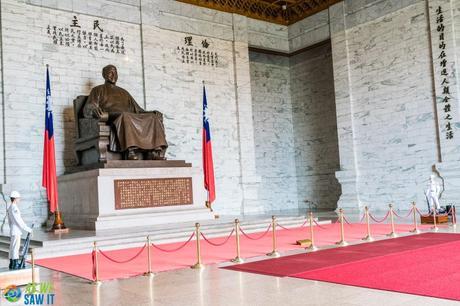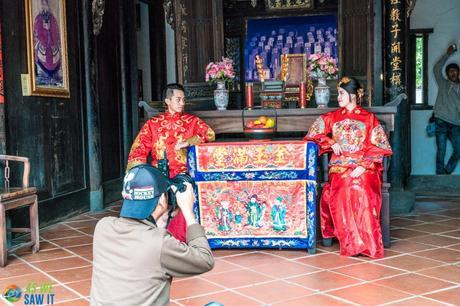If you have ever flown overseas, you may recall how incredibly boring and uncomfortable the trip can be. We have found that the best way to survive a long trip is to schedule a long layover midway through the trip. Get out of the airport, stretch your legs, and see a new place for a few hours.
Which is why we scheduled a day in Taipei during our flight to Asia.

Taipei in one day?
Taiwan offers a free half-day tour of Taipei to transit or transfer passengers with 7- to 24-hour layovers. That was our plan too … until a last-minute schedule change made us ineligible. We would be in Taipei for slightly longer, and they were strict on the rule.
So we had two options:
- Do-it-yourself sightseeing. Find a one-day itinerary, then use Taipei’s excellent public transportation to see a few of the must-see sights on our own.
- Take a tour. Let a local plan the route, handle the dining arrangements and manage the transport.
Take it from us: If you think you can see all of Taipei in a day or two, think again. We discovered that Taipei City has so much to offer that you could easily spend a week there and still not get your fill of its experiences. Don’t be surprised if you want to return for more.

Let a local show you around Shilin Night Market in Taipei.
Penny wise and pound foolish
The more we thought about it, the economical DIY option seemed less sensible. Tired travelers might not navigate a new transit system efficiently. Getting off at the wrong stop would be a waste of time, money and energy.
Besides, this might be our only opportunity to see Taiwan’s capital. We wanted to see as much as possible. It seemed that DIY sightseeing would be “penny wise and pound foolish,” as the Brits might say.

One day in Taipei – we did it!
Finally, we found a one day Taipei tour that would take us to 8 sights. I don’t think we could have seen that much on our own, especially as first-time visitors.
Even though it wasn’t a private tour, it was small: just us and one other family. Our guide introduced us to the most popular and worthwhile attractions in the city.

Here are the 8 sights we saw on our Taipei tour:
1. Presidential Office Building
We began our tour with a stop at the Presidential Office Building for a few photo ops. The building was a governor’s mansion during Taiwan’s Japanese colonization.
I was more interested in a nearby memorial that our guide did not point out. Since I had never heard of the White Terror, I asked about it. She gave us a nutshell history lesson, explaining that they are not proud of this period of Taiwan’s history. Briefly, the White Terror was a long period of martial law in which the government, triggered by an anti-government uprising, suppressed political dissidents and others.

According to our guide, there’s not much to see inside the Presidential Office Building. Just offices.

Adjacent memorial to victims of the White Terror.
2. National Chiang Kai-shek Memorial Hall
Next, we drove to the National Chiang Kai-shek Memorial Hall, arguably the best-known landmark in all of Taiwan.
Built to honor the founder of the Republic of China, its main hall houses a bronze statue of the hero. Downstairs is a museum of Chiang’s life, complete with sedans and uniforms.
We arrived near the top of the hour, so we were able to watch the Changing of the Guard ceremony. Even if you are not into memorials, the synchronized rifle twirling is worth watching.

The large bronze statue of Chiang Kai-shek is watched over by two motionless honor guards. I would imagine that the guards are relieved when their shifts are over. They will lose their monthly time-off if they move at all. Even blinking is not permitted. (Ouch!)


The building and grounds are is full of symbolism. Its 89 steps stand for Chiang Kai-shek’s age at the time of his death. Also, the white walls, blue-tiled octagonal roof and red flowerbeds represent the colors of the Republic’s flag.
3. Longshan Temple
Longshan Temple is probably Taiwan’s best-known temple. Dating from 1738, it was built by settlers from Fujian province as a gathering place for Chinese immigrants. Since then it has been rebuilt many times, thanks to earthquakes, fires and even an air raid.
As we approached, our guide pointed out the dragon guarding the right door and the tiger guarding the left. Dragons represent power, creativity, wisdom, and good fortune. Tigers are powerful animals, symbolize heroism, and are believed to protect people from misfortune.

Visitors should always enter a temple through the Dragon Door and leave through the Tiger Door, we were told.
Once inside, we found the temple crowded with worshippers. On the 1st and 15th day of each lunar month, regular visitors will come to the temple to worship and petition the gods for favor. We had arrived while a ceremony was going on. The chanting and gonging added to the experience as we walked among the faithful.

Longshan Temple is Buddhist and has a central hall with a statue of Buddha. It is dedicated to Guan Yin, sometimes called the Goddess of Mercy, who represents compassion in the Buddhist faith. And there are side rooms with statues and altars to other Chinese deities as well. It would be interesting to learn how it all fits together in the worshipper’s mind.

4. Taipei 101
Taipei 101 is so named because it is 101 stories tall. We were scheduled to stopped there for lunch, but our guide took a short detour first. She knew we would want to photograph the landmark and knew just the place to do it.
Dan and I shared a laugh when we saw a couple posing with a photographer. It seems that wherever we go we run across couples posing for their upcoming weddings! In many countries it is customary to hire a photography/clothing/makeup team to immortalize the event. Taiwanese can spend thousands of dollars on this part of the wedding, because outfits and locations can be quite elaborate.
Of course, we couldn’t resist capturing a few shots of our own.




Finally it was lunchtime. I was surprised to learn that Taipei 101 has five floors belowground as well. I guess it could have been named Taipei 106, but either way, it is still one of the world’s tallest skyscrapers. We spent an hour here, with the option to purchase lunch in its (massive!) food court or to visit the observation deck on the 89th floor.
Tip: Don’t bother to buy a ticket to the observation platform if it’s hazy. The view is only good in clear weather
We opted for lunch because food always wins with us. Besides, we wanted to try the beef noodle soup. Taipei likes it so much that it has an annual festival of its own devoted to the dish. (We’d guess our restaurant didn’t win any awards in the competition. It was bland.)

5. Lin An Tai Historical House
After lunch we were brought to Lin An Tai Historical House. This open-air museum is about 200 years old, which makes it one of the oldest houses in Taipei. Lin An Tai is a very refined Fujianese-style home. It was built by successful immigrants from Fujian, who designed and oriented to have especially auspicious feng shui.
It wasn’t much to look at from the front.

However, once we passed over the threshold I found it enchanting. Please see our Lin An Tai gallery for close-ups; there are too many to share here.
The 25-building complex has a traditional Chinese courtyard that comes complete with a pond, arched bridge, stepping stones, intricate carvings, and several pavilions.



Lin An Tai House is so unique that when road construction threatened its existence, Taipei opted to move the house piece-by-piece rather than tear it down. Unfortunately, they rebuilt the house in a less auspicious location, so they needed to create an artificial mountain with a waterfall to compensate.
And yes, here as well. Never would the builders have suspected that one day the Taiwanese would use it for wedding photos.


6. Beitou Hot Springs – Thermal Valley
Taiwan is a volcanic island. We next drove out to the Thermal Valley, where we spent an hour exploring the Beitou Springs area with our guide. The temperatures of the springs are in the range of 55° to 58° Celsius (131.0°-136.4° F). They are very effective in healing dermatosis and arthritis. Judging from the many spas and hotels in the Thermal Valley, this looks like a popular place to go for a bit of rest and relaxation.
I made a mental Note to Self: The hot springs would make for a relaxing layover.


And again. Can you guess what they’re doing here? (HInt: Notice the changing tent and the white dress.)


7. National Palace Museum
When Chiang Kai-shek had to flee mainland China, he managed to bring many of the country’s historic treasures to Taipei with him. Our next-to-last stop was at the National Palace Museum to see many of these paintings, calligraphy, ceramics and bronzes.

Don’t miss this museum. It’s wonderful.
This single museum is said to house 10 percent of the important cultural artifacts from 7,000 years of Chinese civilization. That’s pretty remarkable! Our visit began with a guided tour of its most famous treasures, including the jadeite cabbage, the meat-shaped stone (created from banded jasper) and the Mao Gong Ding cauldron.

“Mao-Gong Ding,” a 3,000-year-old bronze ceremonial cauldron, contains an encouraging message from the emperor to his governor.

Can you see the grasshopper on the Jadeite Cabbage?
We then had some time to walk around the museum on our own.


8. Shilin Night Market
Our tour ended at Shilin Night Market, the largest night market in Taipei. Believe me, there are more delicious food and shopping options here than you can possibly imagine!

Since it was the drop-off point, everyone could stay as long as they wished before making their own way back to their hotel or next sightseeing destination. (The Jintian metro station is nearby.) However, Dan and I had toured Shilin Night Market the night before, so they kindly offered to drive us back to our airport hotel.
Inspired?
Taiwan Tourism Bureau has many useful resources for planning your trip.
See more photos from our layover in our Taipei photo gallery.
Articles you may enjoy:
- Aussie on the Road shared his one day Taipei experience.
- True Nomads’ guide to what to do in Taipei has even more ideas.
Read more on Amazon:
- Taipei In a Day by Scott B. Freiberger
- Top Ten Sights: Taipei by Mark Jones
- Taipei Travel Guide (Unanchor) – 72 Hours in Taipei: The All-rounder by Sam Cooke
Share this story with your friends.
(Visited 9 times, 7 visits today) Tweet Flip +12 Share5 Pin StumbleShares 7
